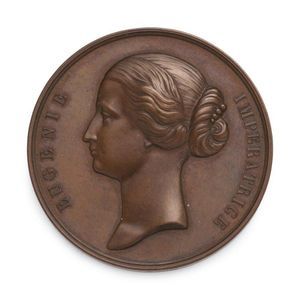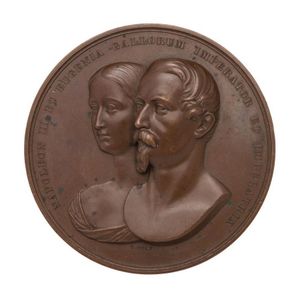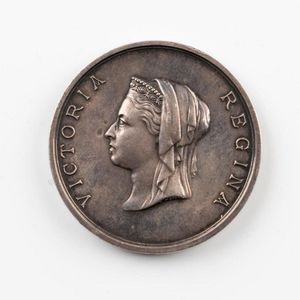1885 International Inventions Exhibition Prize Medal
You must be a subscriber, and be logged in to view price and dealer details.
Subscribe Now to view actual auction price for this item
When you subscribe, you have the option of setting the currency in which to display prices to $Au, $US, $NZ or Stg.
- Obverse - Obverse means the front face of a coin or medal, and the reverse means the back face. The obverse of a coin is commonly called heads, because it often depicts the head of a monarch or famous person.
- Bronze - An alloy of copper and tin, traditionally in the proportions of about 9 parts of copper to 1 part of tin.
The discovery of bronze in Western Asia in the 4th century enabled people to create metal objects which were superior to those previoulsy possible because of its strength and hardness, and it has been used throughout the world for weapons, coins, tools, statuary and other decorative items.
It is very fluid in a molten state, and its hardness, strength when set, and non-corrosive properties makes it most suitable for casting sculpture. - Lyre Motif - The lyre motif is an ancient decorative design that is believed to have originated in ancient Greece, where the lyre was a popular musical instrument. The lyre itself was often decorated with ornate carvings and designs, including the iconic lyre motif.
In ancient Greek mythology, the lyre was associated with the god Apollo, who was the patron of music and the arts. The lyre was said to have been invented by the god Hermes, who presented it to Apollo as a gift. As a result, the lyre became a symbol of creativity, inspiration, and artistic expression.
The lyre motif typically features a curved or S-shaped body, with strings extending upwards from the base. The motif was often used in architectural decoration, as well as on pottery, jewellery, and other decorative objects.
This item has been included into following indexes:
- medals and medallions
Visually similar items

Bronze medal (76 mm), Queen Victoria veiled bust left by Stokes; edge inscribed 'J. Matthews - Juror'.

The Czar in London: A bronze commemorative medal for His Imperial Majesty The Emperor of All The Russias, Alexander II, with bust to one side and 'Alexander II Russorum Imperator', and verso 'Servorum Emancipator Liberae Civitatis Hospes. XVIII Maii Mdcccl

Copper medal (53 mm; 70gm) by Hamel of Rouen; Obverse: Eugenie - Imperatrice bust left; reverse: Exposition Nationale De Nantes 1861 with arms of the city. Uninscribed award medal. In original round wooden case.

England: Reception of Napoleon III and Empress Eugenie At the Guildhall, London, April 1855. Bronze medal by Benjamin Wyon. 1855, Bronze, 76 mm; 249g. Obv: Conjoined busts of Emperor Napoleon III and Empress Eugenie: Napoleon III Et Eugenia Gallorum Impera
